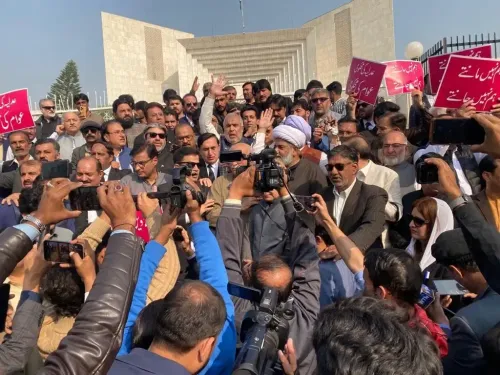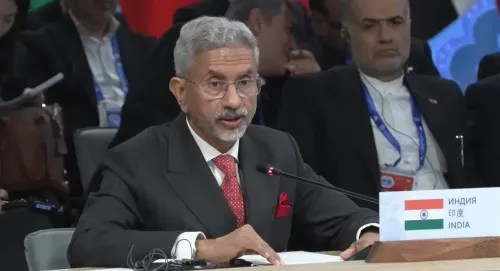Is the Operation of Flights from the China-Funded Airport in Nepal Viable?

Synopsis
Key Takeaways
- Pokhara International Airport struggles to attract international airlines nearly three years after its inauguration.
- Concerns about operational viability arise from the airport's design flaws.
- Only Himalaya Airlines operates weekly flights to Lhasa.
- A tragic accident shortly after opening raises safety concerns.
- The Nepali government faces pressure to manage financial implications of the airport.
Kathmandu, Nov 18 (NationPress) Almost three years post its inauguration on January 1, 2023, the Pokhara International Airport in the picturesque tourist city of Pokhara is facing difficulties in attracting international airlines, prompting fears that this multi-million-dollar investment may turn out to be a substantial financial misstep.
Currently, only Himalaya Airlines, a Nepal–China joint venture, operates a weekly scheduled flight on the Pokhara–Lhasa route, which commenced in March this year.
A government-appointed high-level study committee has pinpointed deficiencies in the airport's physical and navigational designs, imposing weight restrictions on medium-haul flights to and from the airport, thus raising concerns regarding operational costs for airlines considering regular services.
According to the report from the High-Level Study and Recommendation Committee for Reforms in the Civil Aviation Sector, “The airport requires a five percent climb gradient for the Missed Approach Procedure Design Gradient, which is deemed high from a technical perspective for aircraft.”
Furthermore, the report highlights that medium-haul jet aircraft face a load penalty of four to six tonnes upon arrival, and weight restrictions during departures due to the available runway length, impacting both passenger and cargo capacity of airlines.
Led by the current Minister for Industry, Commerce and Supply, Anil Kumar Sinha—also a retired Supreme Court judge—the report indicates that the existing runway length of 2500 metres limits airline operations, particularly in high-temperature, heavy-weight, or low-pressure weather conditions.
A senior official from the Civil Aviation Authority of Nepal (CAAN) acknowledged the findings but emphasized that it is the airlines' prerogative to determine their operational strategies at this airport.
“It is a 4D-standard airport. Airlines have their own operational manuals and can manage flights here based on their assessments of load penalties,” stated Pratab Babu Tiwari, CAAN's spokesperson, in an interview with IANS. “They can evaluate the financial feasibility of operating from this airport by considering these load penalties.”
In aviation terms, a load penalty signifies a reduction in the weight an aircraft can carry—including passengers, cargo, and fuel—due to operational or safety constraints. Elevated load penalties limit the number of passengers and cargo a plane can transport, directly influencing the profitability of airline operations.
An Instrument Landing System (ILS) has been installed to facilitate safe landings under low visibility and adverse weather conditions. However, the report notes that this system has limited effectiveness due to geographical constraints. To enhance the suitability of Pokhara International Airport for international flights, the report advocates for further studies to implement advanced Performance-Based Navigation (PBN) technologies.
This report comes at a time when international airlines remain hesitant to establish regular flights to this airport, despite various incentives announced by CAAN to stimulate international operations at the newly constructed facility.
Despite congestion at Kathmandu's Tribhuvan International Airport, many international airlines are still reluctant to operate flights to both Pokhara International Airport and Gautam Buddha International Airport in the southwestern city of Bhairahawa.
Notably, the airport experienced a tragic incident shortly following its inauguration. A plane from Yeti Airlines crashed near the airport on January 15, 2023, while approaching for landing, resulting in the death of all 72 passengers aboard. The ATR 72 crashed into the Seti River gorge, just 1.5 km (0.9 miles) from the airport.
Concerns regarding the Pokhara International Airport's suitability for medium-haul flights have emerged, particularly as Nepali politicians and bureaucrats involved in the contractor selection process face corruption allegations
A sub-committee from the defunct Public Accounts Committee brought to light multiple irregularities and corruption related to the project's construction and tax exemptions granted to the construction company.
Earlier in 2023, the characterisation of the project by the Chinese side as part of the Belt and Road Initiative (BRI) ignited controversy in Nepal, as the Nepali government declined to classify it as a BRI project, asserting that construction commenced long before Kathmandu signed the Memorandum of Understanding (MoU) on the BRI in 2017.
The airport was constructed by China CAMC Engineering Co. Ltd at a cost of US $215.96 million, funded by China’s EXIM Bank. However, the absence of revenue generation from this project raises significant concerns for the Nepali government, which is now tasked with repaying the Chinese loan.









